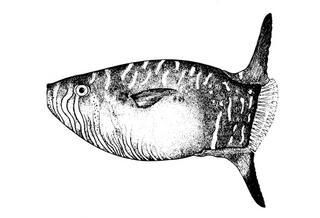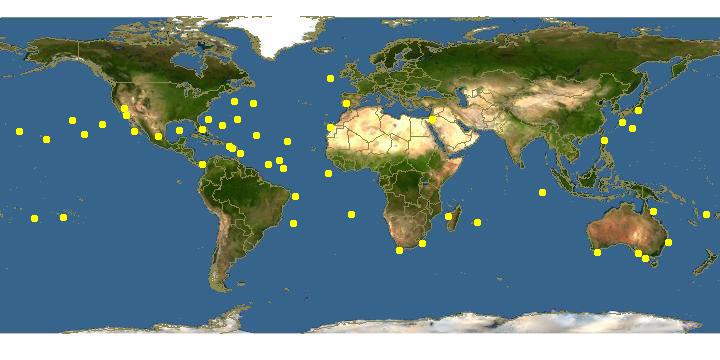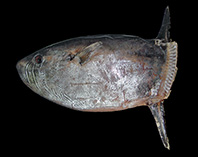
www.fao.org Copyright Michel Lamboeuf · 0
Ranzania laevis |

Click on map for details about points.
|
| Links |
We parsed the following live from the Web into this page. Such content is managed by its original site and not cached on Discover Life. Please send feedback and corrections directly to the source. See original regarding copyrights and terms of use.
- Australian Faunal Directory
- FishBase
|
|
español |
|
|
Overview |
Main identification features
- elongate (length = height x2), compressed
- blue + white bars
- dorsal and anal finslong, pointed
- tail fin very short
Slender mola, Slender sunfish
Elongate, height ~1/3 length; mouth small, in a vertical slit when closed; skin smooth, consists of small, hard, hexagonal plates; dorsal and anal fins long, slender; pectorals long, pointed; tail profile oblique, without rear extension; dorsal 17-19 rays; anal 18-19 rays; pectoral 13 rays.
Dark grey to dark blue above, silvery on sides and belly; head and lower belly with thin undulating black-edged white bars, white spots and vertical streaks on body between dorsal and anal fins.
Size: 100 cm.
Habitat: oceanic.
Depth: 0-200 m.
Circumtropical; possibly throughout our region except most of the Gulf of California.
Attributes
Abundance: Common.
Cites: Not listed.
Climate Zone: North Temperate (Californian Province &/or Northern Gulf of California); Northern Subtropical (Cortez Province + Sinaloan Gap); Northern Tropical (Mexican Province to Nicaragua + Revillagigedos); Equatorial (Costa Rica to Ecuador + Galapagos, Clipperton, Cocos, Malpelo); South Temperate (Peruvian Province ).
Depth Range Max: 200 m.
Depth Range Min: 0 m.
Diet: zooplankton; pelagic fish larvae.
Eastern Pacific Range: Northern limit=35; Southern limit=-20; Western limit=-121; Eastern limit=-70; Latitudinal range=55; Longitudinal range=51.
Egg Type: Pelagic; Pelagic larva.
Feeding Group: Planktivore.
FishBase Habitat: Pelagic.
Global Endemism: Circumtropical ( Indian + Pacific + Atlantic Oceans); East Pacific + Atlantic (East +/or West); Transisthmian (East Pacific + Atlantic of Central America); East Pacific + all Atlantic (East+West); TEP non-endemic; "Transpacific" (East + Central &/or West Pacific); All species.
Habitat: Water column.
Inshore Offshore: Offshore; Offshore Only.
IUCN Red List: Not evaluated / Listed.
Length Max: 100 cm.
Regional Endemism: Island (s); Continent; Continent + Island (s); Tropical Eastern Pacific (TEP) non-endemic; Eastern Pacific non-endemic; All species.
Residency: Resident.
Salinity: Marine; Marine Only.
Water Column Position: Mid Water; Near Surface; Surface; Water column only;
|
|
|
Names | |
|
|
|
Links to other sites | |
|
|
|
References |
- Balart , E. F. , Castro-Aguirre , J. L. , Aurioles-Gamboa , D. , García-Rodriguez , F. and Villavicencio-Garayzar, C., 1995., Adiciones a la ictiofauna de Bahía de la Paz, Baja California Sur, México., Hidrobiologica, 5:79-85.
- Briggs, J.C., 1960., Fishes of worldwide (circumtropical) distribution., Copeia, 1960:171-180.
- Castro-Aguirre, J.L. and Balart, E.F., 2002., La ictiofauna de las islas Revillagigedos y sus relaciones zoogeograficas, con comentarios acerca de su origen y evolucion. En: Lozano-Vilano, M. L. (Ed.). Libro Jubilar en Honor al Dr. Salvador Contreras Balderas., Universidad Autonoma de Nuevo León:153-170.
- Chirichigno, N., 1998., Clave para identificar los peces marinos del Peru., Instituto del Mar del Peru, Informe., 44(2 Ed.):1-387.
- Eschmeyer , W. N. , Herald , E. S. and Hamman, H., 1983., A field guide to Pacific coast fishes of North America from the Gulf of Alaska to Baja California. Peterson Field Guide Ser. 28., Houghton Mifflin:336pp.
- Findley, L.T., Hendrickx, M.E., Brusca, R.C., van der Heiden, A.M., Hastings, P.A., Torre, J., 2003., Diversidad de la Macrofauna Marina del Golfo de California, Mexico., CD-ROM versión 1.0. Projecto de la Macrofauna del Golfo . Derechos reservados de los autores y Conservación Internacional.
- Fischer , W. , Krup , F. , Schneider , W. , Sommer , C. , Carpenter , K. E. and Niem, V. H., 1995., Guia FAO para la Identificacion de Especies de para los fines de la Pesca. Pacifico Centro-Oriental. Volumen III. Vertebrados - Parte 2., FAO3:1201-1813.
- Grove , J.S. and Lavenberg, R. J., 1997., The fishes of the Galápagos islands., Stanford University Press:863 pp.
- Jimenez-Prado, P., Béarez, P., 2004., Peces marinos del Ecuador continental / Marine fishes of continental Ecuador., SIMBIOE/NAZCA/IFEA tomo 1 y 2.
- Lopez , M. I. and Bussing, W. A., 1982., Lista provisional de los peces marinos de la Costa Rica., Revista de Biologia Tropical, 30(1):5-26.
- Love, M.S., Mecklenburg, C.W., Mecklenburg, T.A., Thorsteinson, L.K., 2005., es of the West Coast and Alaska: a checklist of North Pacific and Artic Ocena species from Baja California to the Alaska-Yukon border., U.S. Department of the Interior, U.S. Geological Survey, Biological Resources Division, 288pp.
- Pennant, T., 1776., British zoology. 4th Edition. London., British Zool. 4th ed.,.
- Van der Heiden , A. M. and Findley, L. T., 1988., Lista de los peces marinos del sur de Sinaloa, México., Anales del Centro de Ciencias del Mar y Limnologia de la Universidad Autonoma Nacional de Mexico, 15:209-224.
|
|
|
Acknowledgements | |
I thank Ashley MacDonald and John Pickering, University of Georgia, for technical support in building this page.
|
|
| Supported by | |
|
Following modified from Australian Faunal Directory
|
Top | See original
| &pull 20q v5.145 20180528: Error 301 Moved Permanently http://biodiversity.org.au/afd/taxa/8da949bb-0d08-4e9c-91e2-ed44e6fd36b1 |
|
Following modified from FishBase
|
Top | See original
http://www.fishbase.org/Summary/speciesSummary.php?genusname=Ranzania&speciesname=laevis ---> http://192.134.151.83/Summary/speciesSummary.php?genusname=Ranzania&speciesname=laevis
http://192.134.151.83/Summary/speciesSummary.php?genusname=Ranzania&speciesname=laevis ---> https://fishbase.mnhn.fr/Summary/speciesSummary.php?genusname=Ranzania&speciesname=laevis
https://fishbase.mnhn.fr/Summary/speciesSummary.php?genusname=Ranzania&speciesname=laevis ---> https://fishbase.mnhn.fr/summary/Ranzania-laevis.html
Ranzania laevis, Slender sunfish

You can
sponsor
this page
Common name (e.g. trout)
Genus + Species (e.g. Gadus morhua)
-

-
About this page
-
Languages
-
User feedbacks
-
Citation
-
Uploads
-
Related species
-


 Slender sunfish
Add your observation in
Fish Watcher
Upload your
photos
and
videos
Slender sunfish
Add your observation in
Fish Watcher
Upload your
photos
and
videos
Pictures
|
Videos |
Google image
 Ranzania laevis
Ranzania laevis
Picture by
Jawad, L.A.
Teleostei (teleosts) >
Tetraodontiformes
(Puffers and filefishes) >
Molidae
(Molas or Ocean Sunfishes)
Etymology:
Ranzania:
Because of Camillo Ranzani, 1775-1841, catholic priest and naturalist (Ref.
45335
)
.
Environment: milieu / climate zone / depth range / distribution range
Ecology
Marine; pelagic-oceanic; depth range 1 - 140 m (Ref.
58302
). Subtropical; 71°N - 55°S, 180°W - 180°E
Cosmopolitan. Western Atlantic: Florida (USA), Martinique, Venezuela (Ref.
51183
), and Brazil. Eastern Atlantic: Madeira to Scandinavia (Ref.
4711
); Dakar, Senegambie, and Sierra Leone (Ref.
6952
); South Africa. Eastern Pacific: central California, USA to Chile; rare north of Mexico (Ref.
2850
). Indian Ocean: Madagascar (Ref.
33390
), Mauritius (Ref.
58078
), Reunion (Ref.
53568
), Iran (Ref.
86583
), Australia (49596). West Pacific: Japan (Ref.
559
), China (Ref.
57879
), Taiwan (Ref.
12711
), New Zealand (Ref.
5755
).
Size / Weight / Age
Maturity: L
m
?
range ? - ? cm
Max length : 100.0 cm TL male/unsexed; (Ref.
26340
)
Dorsal
spines
(total): 0;
Dorsal
soft rays
(total): 18;
Anal
spines
: 0;
Anal
soft rays
: 20. Caudal fin present in postlarvae but resorbed during metamorphosis and replaced by a clavus (Ref.
4424
). Body elongated, Mouth slit vertical (Ref.
35388
).
Oceanic (Ref.
2850
), epipelagic (Ref.
2340
), and generally solitary (Ref.
9317
). Feeds on planktonic crustaceans (Ref.
4424
).
Life cycle and mating behavior
Maturity
|
Reproduction
|
Spawning
|
Eggs
|
Fecundity
|
Larvae
Tortonese, E.
, 1990. Molidae. p. 1077-1079. In J.C. Quero, J.C. Hureau, C. Karrer, A. Post and L. Saldanha (eds.) Check-list of the fishes of the eastern tropical Atlantic (CLOFETA). JNICT, Lisbon; SEI, Paris; and UNESCO, Paris. Vol. 2. (Ref.
6952
)
IUCN Red List Status (Ref.
130435
)
Least Concern (LC)
; Date assessed:
07 June 2011
CITES
Not Evaluated
Not Evaluated
Threat to humans
Harmless
Human uses
FAO - Publication:
search
|
FishSource
|
More information
Countries
FAO areas
Ecosystems
Occurrences
Introductions
Stocks
Ecology
Diet
Food items
Food consumption
Ration
Common names
Synonyms
Metabolism
Predators
Ecotoxicology
Reproduction
Maturity
Spawning
Spawning aggregation
Fecundity
Eggs
Egg development
Age/Size
Growth
Length-weight
Length-length
Length-frequencies
Morphometrics
Morphology
Larvae
Larval dynamics
Recruitment
Abundance
BRUVS
References
Aquaculture
Aquaculture profile
Strains
Genetics
Electrophoreses
Heritability
Diseases
Processing
Nutrients
Mass conversion
Collaborators
Pictures
Stamps, Coins Misc.
Sounds
Ciguatera
Speed
Swim. type
Gill area
Otoliths
Brains
Vision
Tools
E-book
|
Field guide
|
Identification keys
|
Length-frequency wizard
|
Life-history tool
|
Point map
|
Classification Tree
|
Catch-MSY
|
Special reports
Check for Aquarium maintenance
|
Check for Species Fact Sheets
|
Check for Aquaculture Fact Sheets
Download XML
Summary page
|
Point data
|
Common names
|
Photos
Internet sources
AFORO (otoliths)
|
Aquatic Commons
|
BHL
|
Cloffa
|
BOLDSystems
|
Websites from users
|
Check FishWatcher
|
CISTI
|
Catalog of Fishes
:
genus
,
species
|
DiscoverLife
|
ECOTOX
| FAO - Publication:
search
|
Faunafri
| Fishipedia |
Fishtrace
| GenBank:
genome
,
nucleotide
|
GloBI
|
Google Books
|
Google Scholar
|
Google
| IGFA World Record |
MitoFish
|
National databases
|
Otolith Atlas of Taiwan Fishes
|
PubMed
| Reef Life Survey | Socotra Atlas |
Tree of Life
| Wikipedia:
Go
,
Search
| World Records Freshwater Fishing |
Zoological Record
Estimates based on models
Preferred temperature (Ref.
123201
): 14.7 - 27.9, mean 23.9 °C (based on 1566 cells).
Phylogenetic diversity index (Ref.
82804
): PD
50
= 1.0312 [Uniqueness, from 0.5 = low to 2.0 = high].
Bayesian length-weight: a=0.02455 (0.01018 - 0.05918), b=3.02 (2.81 - 3.23), in cm total length, based on LWR estimates for this (Sub)family-body shape (Ref.
93245
).
Trophic level (Ref.
69278
): 3.7 ±0.47 se; based on food items.
Fishing Vulnerability (Ref.
59153
): High vulnerability (60 of 100).
Back to Search
Random Species
Back to Top
Accessed through:
Not available
FishBase mirror site :
localhost
Page last modified by :
mrius-barile
- 20 July 2016
Fatal error
: Uncaught ArgumentCountError: Too few arguments to function checkEcotox(), 1 passed in /var/www/html/summary/speciessummary.php on line 2304 and exactly 3 expected in /var/www/html/includes/speciessummary.lib.php:2579 Stack trace: #0 /var/www/html/summary/speciessummary.php(2304): checkEcotox() #1 {main} thrown in
/var/www/html/includes/speciessummary.lib.php
on line
2579
|
Updated: 2024-06-19 20:57:32 gmt
|